

Using GWT widgets in Vaadin 7 - Part 1. We Recommend These Resources Even if Vaadin provides you with plenty of components out-of-the-box, chances are sooner or later, you'll want to use that special GWT widget you just saw the last day. Demo.vaadin.com/vornitologist/VAADIN/tutorial/touchkit-tutorial.html. Matti Tahvonen Marko Grönroos In this tutorial, we introduce you to how the Vornitologist demo app was built.
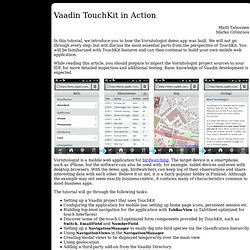
We will not go through every step, but will discuss the most essential parts from the perspective of TouchKit. You will be familiarized with TouchKit features and can then continue to build your own mobile web application. While reading this article, you should prepare to import the Vornitologist project sources to your IDE for more detailed inspection and additional testing. Basic knowledge of Vaadin development is expected.
Vornitologist is a mobile web application for birdwatching. The tutorial will go through the following tasks: Setting up a Vaadin project that uses TouchKit Configuring the application for mobile use: setting up home page icons, persistent session etc. In Bed with Vaadin and OSGi. Kai's Blog » Dynamic modular Web Applications with Vaadin and OSGi. I am a big fan of both OSGi and GWT (Google Web Toolkit).

Unfortunately these two technologies don’t fit together very well. When you want to run OSGi on the server, RAP (Rich Ajax Platform) is one proven approach to go. While I like RAP a lot, you have to have quite a lot of Eclipse RCP know how for using it. Another alternative, if your want to run OSGi on the server and provide a modular, dynamic UI is Vaadin. Btw, Vaadin is the Finnish word for female reindeer. Concurrent Vaadin // Neil Bartlett. As my colleagues and regular readers know, I have been hugely impressed by Vaadin, a web framework for Java, and have been using it in many of my OSGi demos, tutorials and projects.
This blog post is not about OSGi, but the more general problem of dealing with concurrent updates in a Vaadin application. I describe a technique for updating the application display in response to asychronous events. My own use-case was handling service binding/unbinding events in OSGi, but the technique would equally apply to message processing applications, etc. Vaadin’s programming model feels very much like working with a conventional desktop GUI API such as Swing or SWT/JFace, though it is more elegant than either of those examples. However one aspect where it differs significantly is its lack of an “event thread”, which in desktop APIs is responsible for continuously painting the screen and responding to keyboard and mouse clicks. Become a Partner. Hitch Hiker's Guide to Java: Using Vaadin with Google App Engine.
Under the current situation of misalignment between Google and Vaadin in creating a project in Eclipse, to develop Vaadin applications that would work with Google Plugin for Eclipse, a few minor hurdles need to be jumped over.
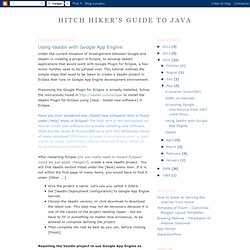
This tutorial outlines the simple steps that need to be taken to create a Vaadin project in Eclipse that runs on Google App Engine development environment. Presuming the Google Plugin for Eclipse is already installed, follow the instructions found in to install the Vaadin Plugin for Eclipse using [Help - Install new software] in Eclipse. Have you ever wondered why [Install new software] item is found under [Help] menu in Eclipse?
The help item is not instructions on how to install new software but actually installing new software. Setting up Vaadin Add-on project. This howto walks you through a complete setup for a project for developing, building and publishing your own Vaadin UI component add-ons.
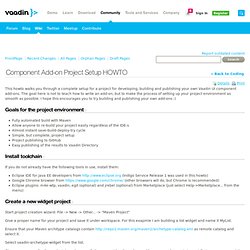
The goal here is not to teach how to write an add-on, but to make the process of setting up your project environment as smooth as possible. I hope this encourages you to try building and publishing your own add-ons :) Goals for the project environment # Fully automated build with Maven Allow anyone to re-build your project easily regardless of the IDE:s Almost instant save-build-deploy-try cycle Simple, but complete, project setup Project publishing to GitHub Easy publishing of the results to Vaadin Directory Install toolchain # If you do not already have the following tools in use, install them: Using Vaadin with Maven - Wiki. (This article was moved from original authors of the article can be seen from the document history).
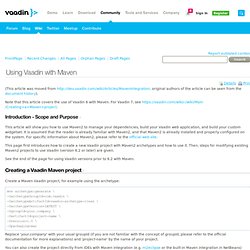
Note that this article covers the use of Vaadin 6 with Maven. For Vaadin 7, see Introduction - Scope and Purpose # This article will show you how to use Maven2 to manage your dependencies, build your Vaadin web application, and build your custom widgetset. It is assumed that the reader is already familiar with Maven2, and that Maven2 is already installed and properly configured on the system. Easy form creation with Fluent Builder pattern in Vaadin - Aceevo. One of the benefits of Vaadin is how easily you can develop a reusable framework to abstract tedious CRUD web application development.
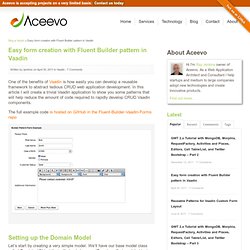
In this article I will create a trivial Vaadin application to show you some patterns that will help reduce the amount of code required to rapidly develop CRUD Vaadin components. The full example code is hosted on GitHub in the Fluent-Builder-Vaadin-Forms repo Setting up the Domain Model Let’s start by creating a very simple model. We’ll have our base model class called PersistentObject that will simply have an ID and our first model object called Customer that will extend PersistentObject. PersistentObject.java Customer.java BeanItemAdapter and BuildableObjectProperty The basic form examples on the Vaadin website show you how to adapt your POJO for editing in a form by using the BeanItem class. BeanItem is a wrapper class for adding the Item interface to any Java Bean. BeanItemAdapter.java. Vaadin Calendar component tutorial. Vaadin scalability-slides. Dynamic and modular Web Applications with Equinox and Vaadin.
Vaadin roadmap. Chameleon Theme. Maven, Spring, Vaadin and Google AppEngine, Happy Together - Streamhead. In true open source spirit, I scratched my itch.
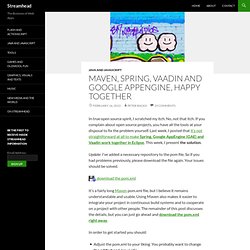
No, not that itch. If you complain about open source projects, you have all the tools at your disposal to fix the problem yourself. Last week, I posted that it’s not straightforward at all to make Spring, Google AppEngine (GAE) and Vaadin work together in Eclipse. This week, I present the solution. Update: I’ve added a necessary repository to the pom file. Download the pom.xml It’s a fairly long Maven pom.xml file, but I believe it remains understandable and usable. In order to get started you should: Adjust the pom.xml to your liking. If you like to know a little more about what the pom.xml does, here are the various issues that are resolved by it.
Google AppEngine The main issue with Google AppEngine is managing the WAR structure. Java classes are compiled to /war/WEB-INF/classesJAR dependencies are managed in /war/WEB-INF/lib (“mvn clean” both deletes the old jar files and copies the new ones in the directory) Joonas Lehtinen on the Web - thoughts on technology, life and everything. Vaadin. Rejoice people, it’s March, time for Devoxx France 2013!

Here are some notes I took during the event. Java EE 7 hands-on lab by David Delabasse & Laurent Ruaud An hands-on lab by Oracle for good old-fashioned developers that want to check some Java EE 7 features by themselves. This one, you can do it at home. Just go to this page and follow instructions. Creating custom widgets with Vaadin Visual Designer · bluesoft-rnd/aperte-workflow-core Wiki. Aperte Workflow provides wide range of customizable widgets, and it is advised to build user interfaces using that set.
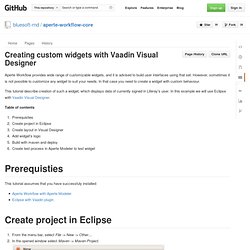
However, sometimes it is not possible to customize any widget to suit your needs. In that case you need to create a widget with custom behaviour. This tutorial describe creation of such a widget, which displays data of currently signed in Liferay's user. In this example we will use Eclipse with Vaadin Visual Designer. Table of contents. Develop Vaadin apps with Scala. More than a year ago, I tried to use Scala to develop an example Vaadin application.
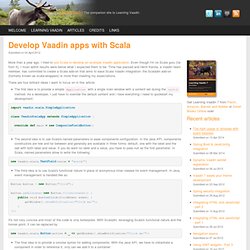
Even though I'm no Scala guru (far from it), I must admit results were below what I expected them to be. Time has passed and Henri Kerola, a Vaadin team member, has commited to create a Scala add-on that aims to ease Scala Vaadin integration: the Scaladin add-on (formerly known as scala-wrappers) is more than meeting my expectations. There are four brilliant ideas I want to focus on in this article: The first idea is to provide a simple Application with a single main window with a content set during the init() method.
Lazy Query Container - Wiki. When to Use Lazy Query Container? # Typical usage scenario is browsing a large persistent data set in Vaadin Table. LQC minimizes the complexity of the required custom implementation while retaining all table features like sorting and lazy loading. LQC delegates sorting of the data set to the backend data store instead of sorting in memory. Creating a Modular Vaadin Application with OSGi - Wiki. By Petter Holmström Update April 13, 2010: The original article contained a bug that prevented the application from working correctly with multiple users. The bug has now been fixed. Thanks to Cedric Gillet for discovering the bug! Introduction # One of the strengths of rich client platforms such as Eclipse or NetBeans is their modular design.
In this article, we are going to create a modular Vaadin application, where UI modules can be added and removed on the fly without having to redeploy or even restart the application. It may not look very fancy – the main window consists of a tab sheet only – but every tab is in fact loaded from a separate module. Prerequisites # Small steps with big feet » Blog Archive » How to: Vaadin add-ons and Maven. Introduction.